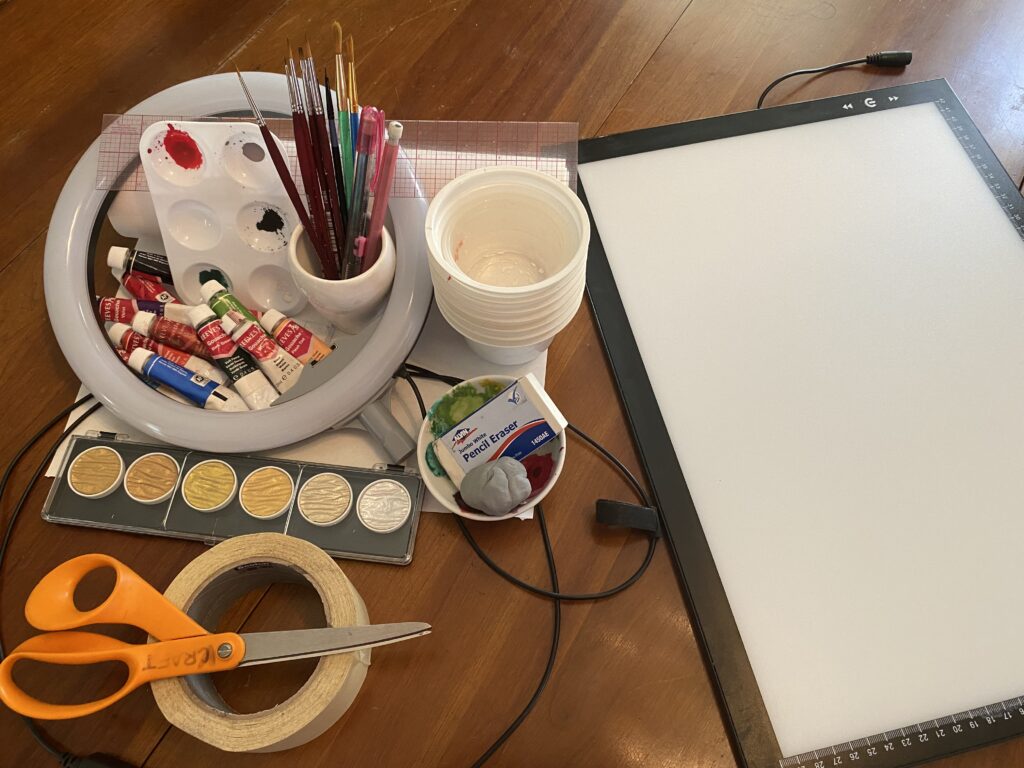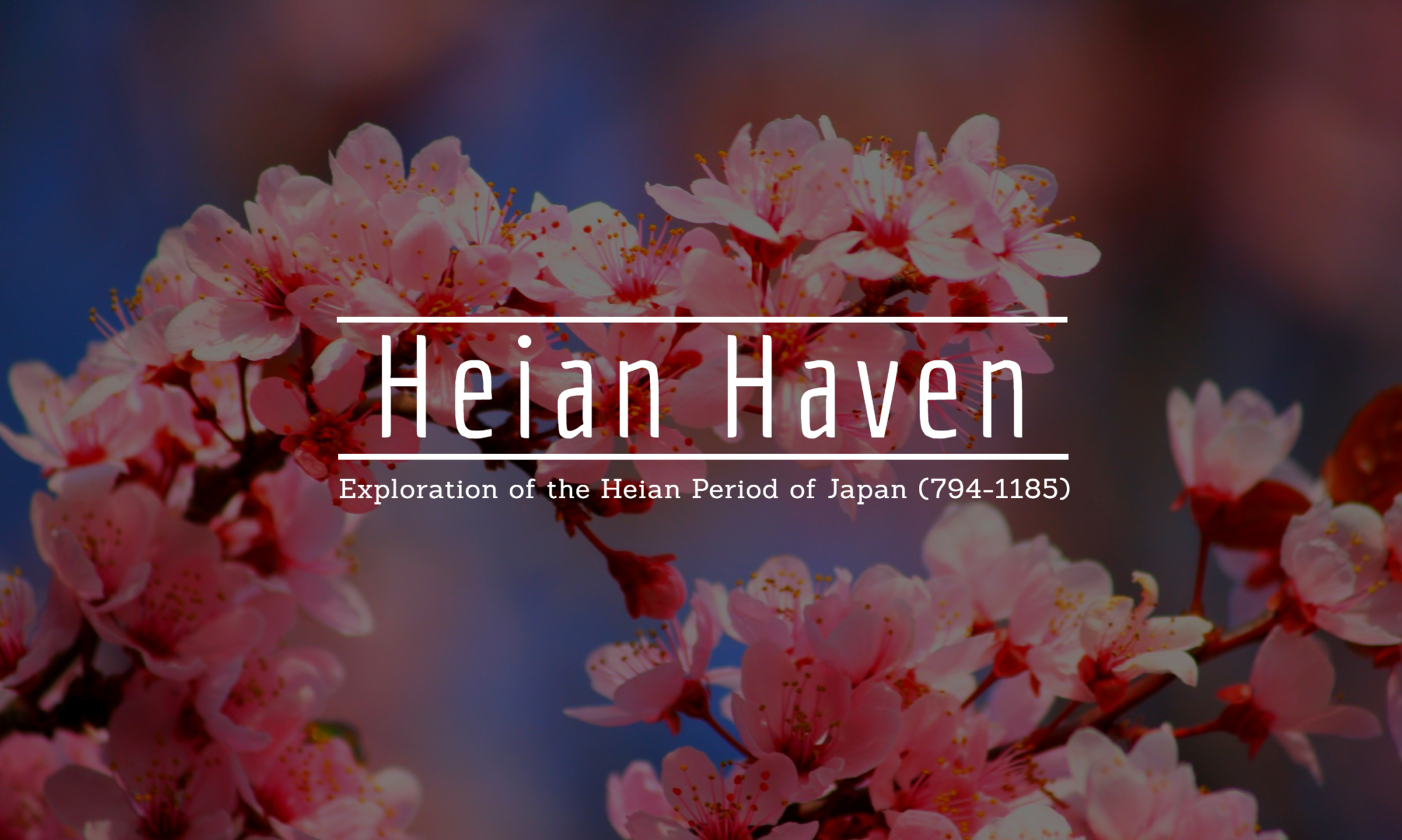On July 11, Lady Phaedra de Vere was inducted into the East Kingdom’s Order of the Silver Wheel for her service. With Þorfinn Hróðgeirsson’s words, I created a Tang Chinese inspired scroll for the occasion. This was my first scroll for the East Kingdom.

This was the most difficult scroll I’ve ever completed. I failed twice in its making. I lost faith in myself and my skill at times. But with the help of dear friends I kept going, and in the end it came out beautifully. And the recipient is very happy which is the most important part. What follows is the timeline of events leading to the completed scroll with progress photos.
Thursday, March 18 – I receive word that a dear friend is to be inducted into the East Kingdom’s Order of the Silver Wheel. An image forms in my mind for the scroll. I see the recipient, resplendent in her Tang garb gazing into a pond that reflects the moon as the silver wheel she is being awarded. Her heraldry is a white lily, so I muse that including white lilies might be nice.
Friday, March 19 – I reach out to the Tyger Clerk to volunteer to create the scroll.
Sunday, March 21 – Instructions for how to officially volunteer for scrolls are provided. In my excitement, I misunderstand the instructions and started happily working on the scroll. I reach out on the SCA Scribes and Illuminators group on Facebook to find a calligrapher. I have a few offers and recommendations from that group. The post is briefly shared to a group the recipient is in. I fret that the surprise has been blown.
Monday, March 22 – A translator that had been recommended reached out to me. Information was shared and as they know the recipient, and agreed to compose an appropriate poem for the occasion. I order two each of two different premounted scroll blanks. I reached out to someone who offered help with research and composition. And I am indebted to Taylor Chen for their assistance. I’m in luck that my initial idea can be done in a decidedly period fashion. My artistic consultation provides a plethora of research options and a crash course in Tang culture and art. I create a webpage for my scribal work so the Scribal Office can see my past work, and fill out the forms to be an official East Kingdom Scribe.
Thursday, March 25 – The scroll blanks have arrived! Oddly enough, the slightly smaller scroll blank is my preference. It is backed in silk while the slightly larger is backed with paper. (I somehow fail to notice that the larger is paper for the ground as well.) I also like the darker contrast fabric framing the cream silk around the paintable area more than the solid white one.
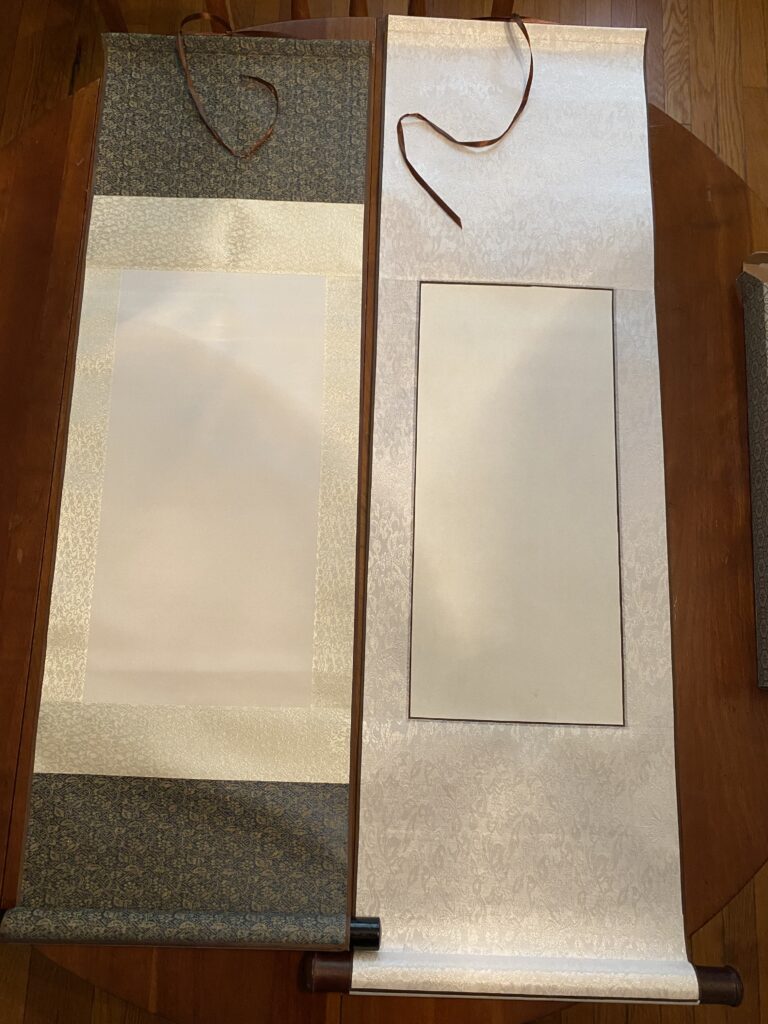
Luckily I will be able to use my new lightpad with either, and that relieves some of my stress knowing that I won’t have to freehand the whole thing. I need to start sketching soon, as the image/painting needs to be complete before I can send it to the calligrapher. I’m terribly excited (and a little nervous) about the whole project. I think I’d like to get the illumination (painted) portion of the scroll finished no later than the end of April so there are 2 full months available for the calligraphy.
March 27 – After an email from the Tyger Clerk, I realize that I was working on the scroll prior to having the official assignment. It causes me some anxiety that I had made that kind of mistake, but is sorted when I then receive the official assignment email.
March 28 – I confirm the official assignment. The scroll is due July 4th, so I relax my end of April deadline a little to May.
April 1 – Last night the person writing the words sent the first draft of the poem. It’s amazing. And beautiful. And so well researched and constructed. They’ve taken the generic scroll text I came up with and created a poem in an ancient Chinese style IN CHINESE. I am in awe of this individual’s talent.
April 2 – I’ve essentially finished my research phase of the project. I have a curated selection of period images and a couple from later but still within SCA period as well as a modern painting or two. The later period examples (circa 1500) are for style suggestions, and a cheeky but hopefully subtle inspiration from paintings of the goddess of the moon. The modern painting details lilies. I have a Tang reference image, provided by Taylor, but the modern one shows a detail in use of colour that I think I would like to emulate. I’ve also done an initial sketch of the scroll, full size. I’m encouraged by it. I’m going to alter the figure’s stance to emulate a Tang image of a court lady, the farthest left from Zhou Fang’s Court Ladies Adorning Their Hair With Flowers. I plan to have the figure holding a long handled paddle fan. I aim to complete at least one sketch per day until I have the final image.
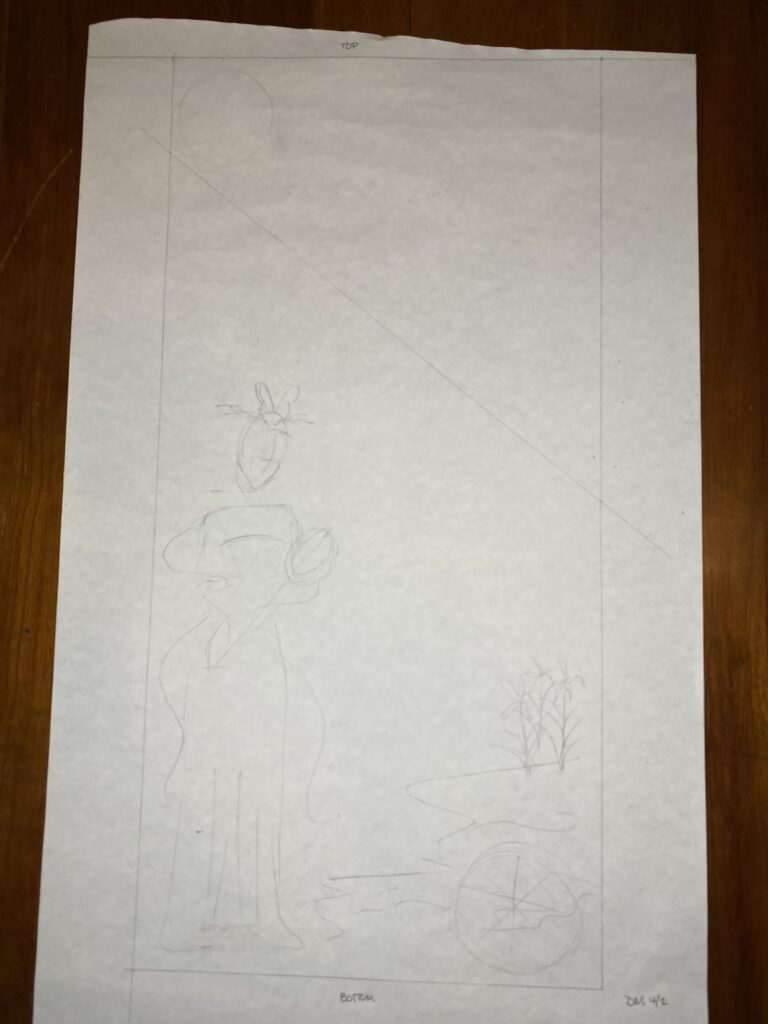
April 3 – Second sketch done. This is more a line drawing than a sketch. I think I have the proportions right, the angles all look good. The pond is discernably a pond. The lady actually looks like she’s looking into the pond. I stretched the silver wheel “reflection” just slightly and tried to match the angle of the water to good effect. There’s this beautiful line created through the composition from the moon through the figure’s gaze and into the pond’s reflection that just makes me SO happy. This is not the line angled through the piece, that was to mark off the space for text. I spend just a moment wondering how to detail the hands before sketching the long-handled paddle fan in. It’s perfect. The next iteration will detail the hair.
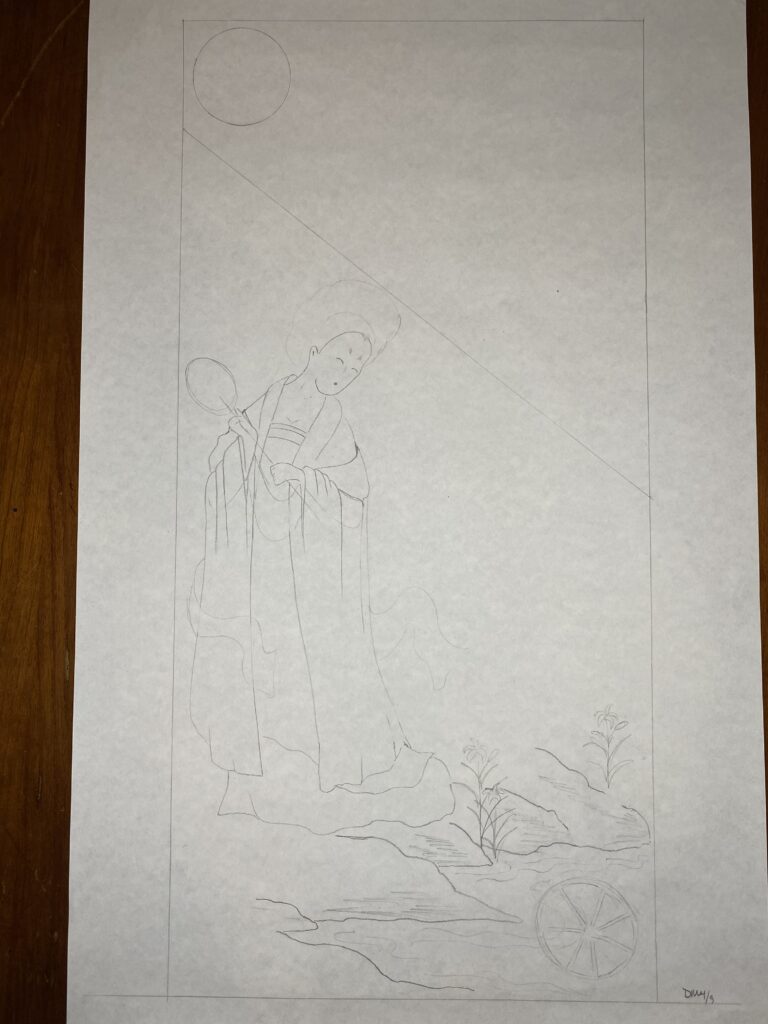
April 11 – Third iteration complete. I based the hair on the recipient’s wig called “Steve.” I share a picture with the person who helped me with research. They suggest that the leaves of the lilies blow in the breeze as the figure’s scarf is “fluttering in the breeze”. I make the change and it gives the image a wonderful sense of movement.
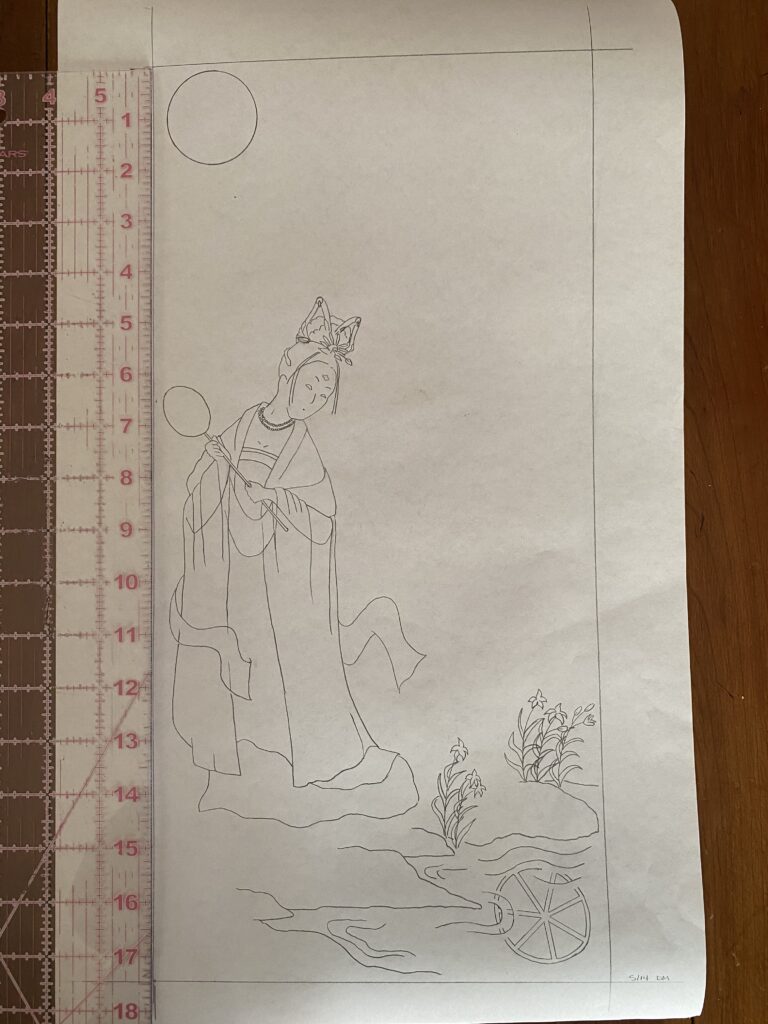
And then I could not art for a month.
May 14 – I “complete” the final line drawing. This is the version that is ready for transferring onto the scroll. It does not yet have the patterns for the fabric details as I’m mulling those over.
May 15 – The calligrapher may have an issue.
May 23 – The wordsmith wants a little time for rewrites. Not a problem as I no longer have a calligrapher to write his words. Herein starts a mad scramble to find a new one. Spoiler alert, I don’t.
May 24 – I briefly lose my mind about the project. I consider redesigning to a late period English style. I seek advice from a friend who helps me break everything down and be much more rational about the whole thing. I owe His Lordship Roibeard mac Neill mhic Ghille Eoin a great debt. He asks for progress reports in return.
May 25 – Baroness Audrye Beneyt begins her 25 minutes for 25 days challenge. I use it as a prompt to get the scroll completed, sort of.
May 30 – Practice image created on scrap silk using ground Chinese ink.
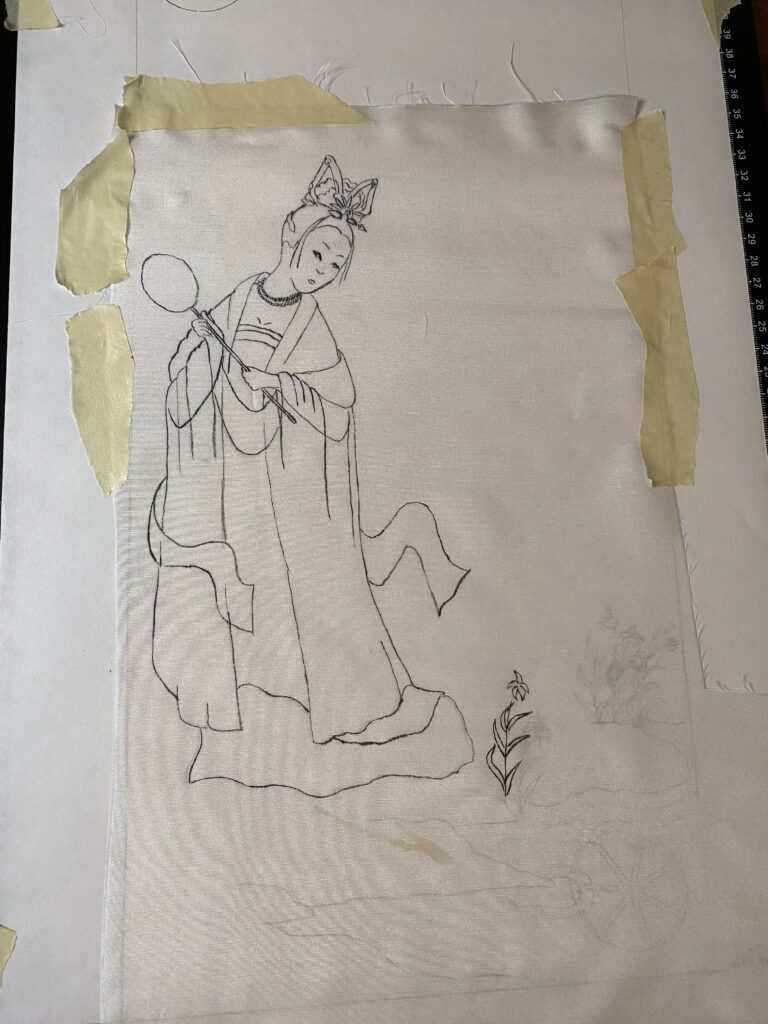
Image transferred to the scroll blank. I first taped the line drawing to the lightpad and then the scroll blank over that. It was traced directly onto the silk with freshly ground ink.
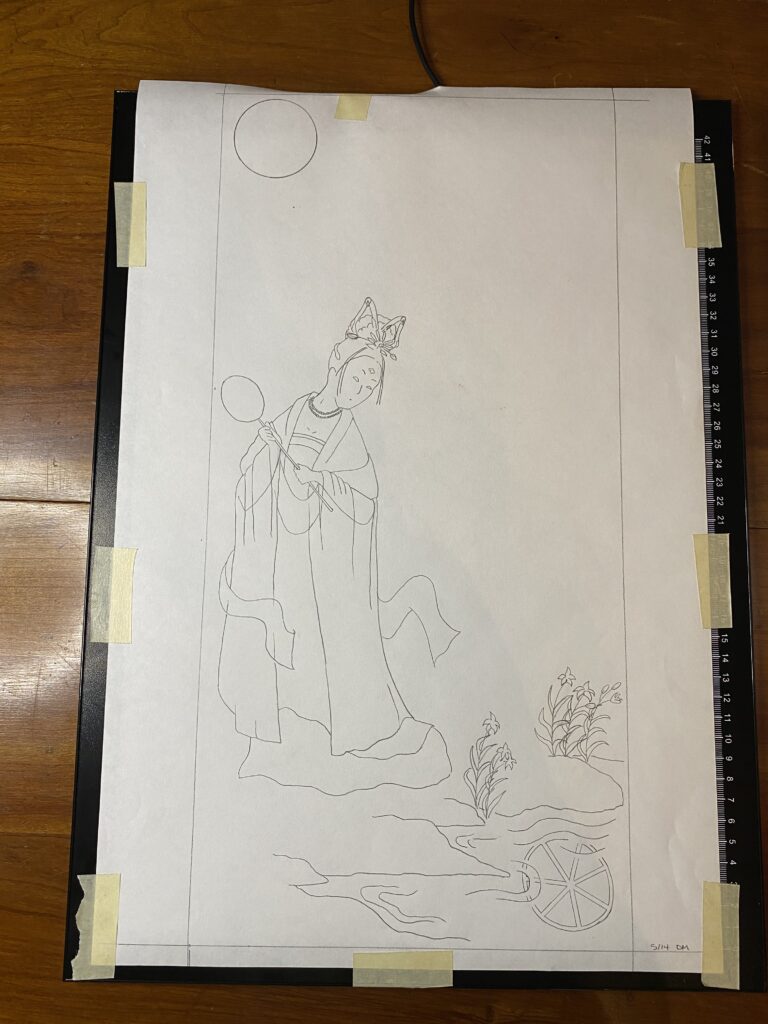


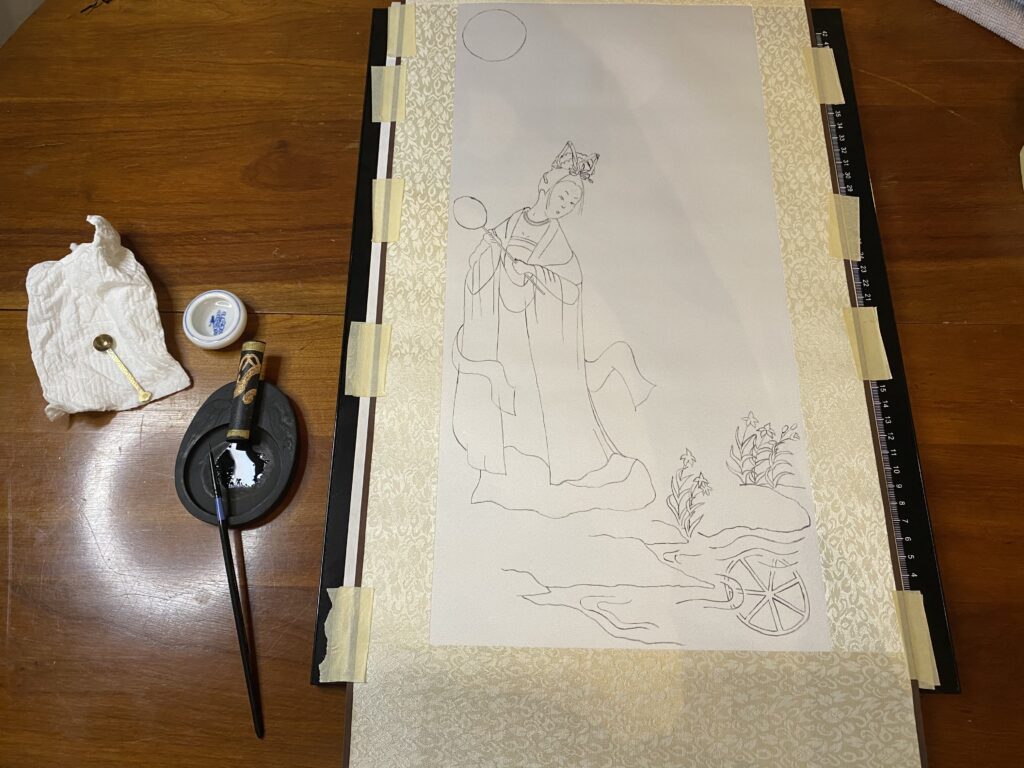
And then I stared at it for days. And I mixed the paint colors.
June 7 – I let the wordsmith know I’m unable to secure a replacement calligrapher. I ask if they mind if I do it. I’m confident I can copy the characters legibly.
And then I stared at it some more.
June 10 – The recording session in which the recipient is awarded her silver wheel happens tonight. She was very surprised.
June 11 – I add fabric details to the line drawing and tape down the practice silk to cardboard. I did not take photos of progress on the practice silk.
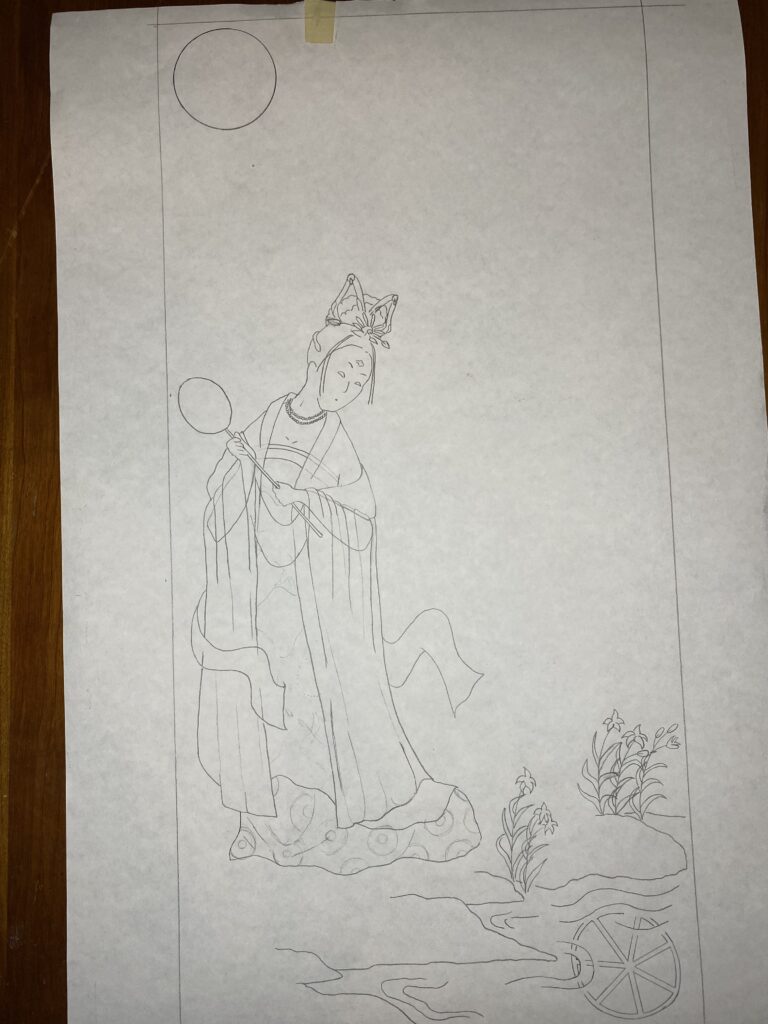
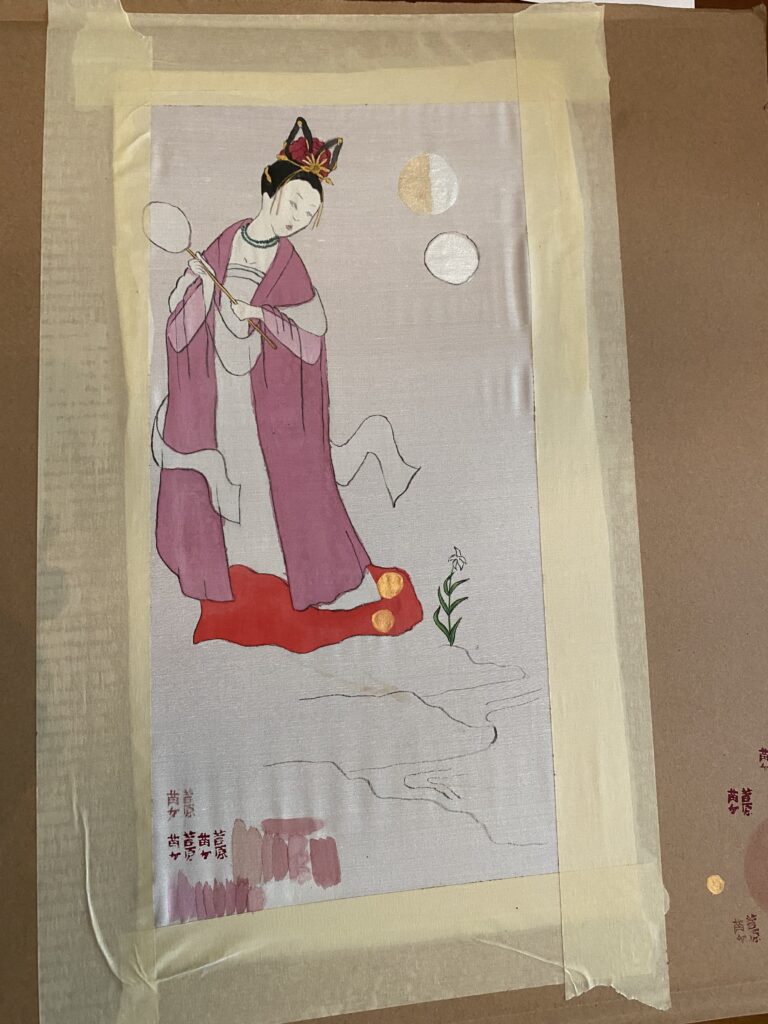
June 12 – Base paint layer of white added. Green added to lilies. That halo of white around the moon is a portent of things to come. Cue my anxiety over how much the paint is going to bleed. I’ve painted silk before, but not quite like this. The nagging doubt I had about how well the “prepared” scroll blank was actually prepared seems warranted.
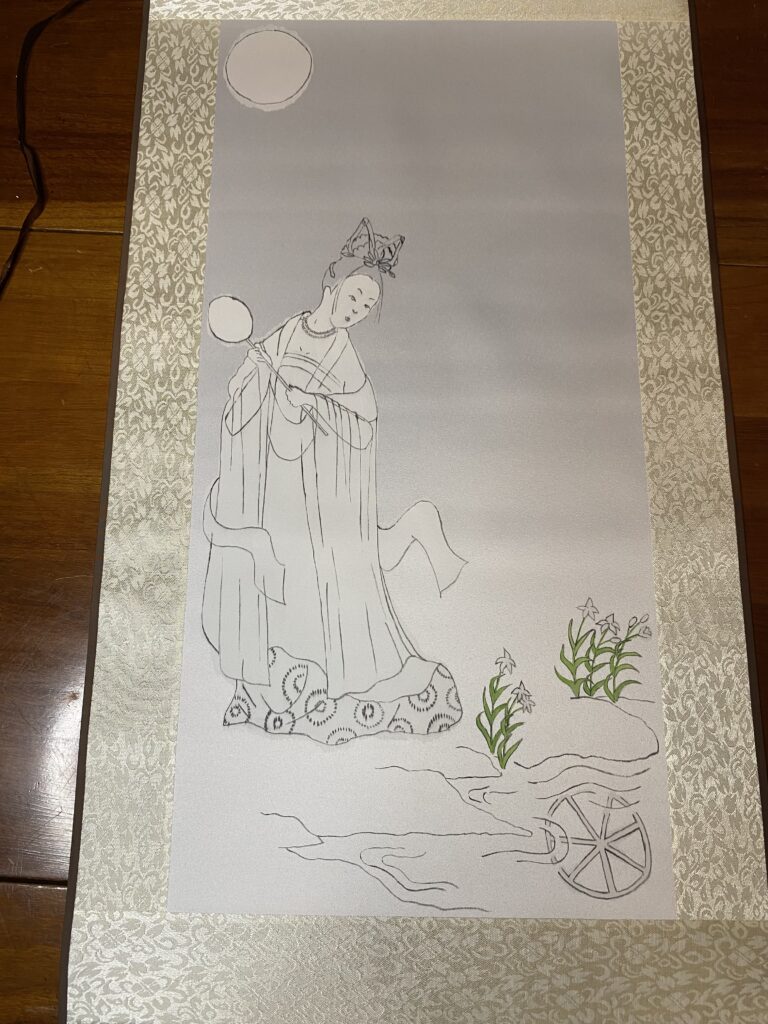
June 14 – Skin, hair, moon and flower in the hair painted. Minimal bleeding.
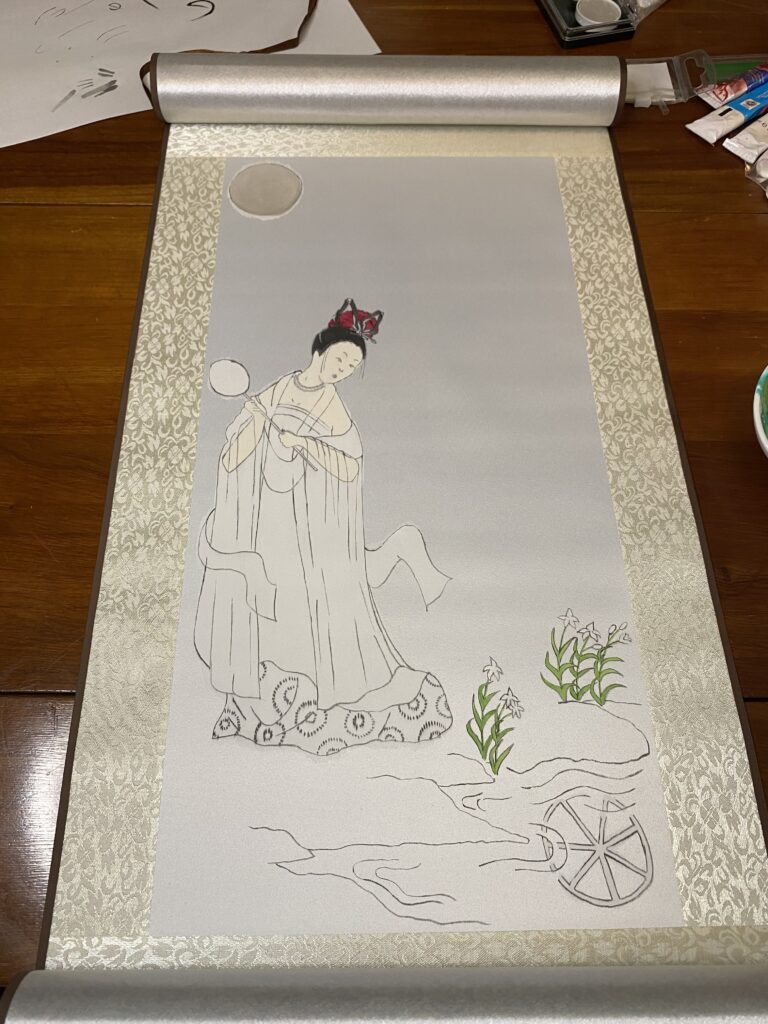
June 16 – Water, lower skirt and wheel painted. The bleeding of the paint is slight, but it has me very worried. I paint the band at the bust and want to cry. But I think it’s still salvageable.

June 18 – Painted in the large color block and the paint bled very badly. I reach out to a different friend to see if it’s as bad as I think. She confirms what I already know.
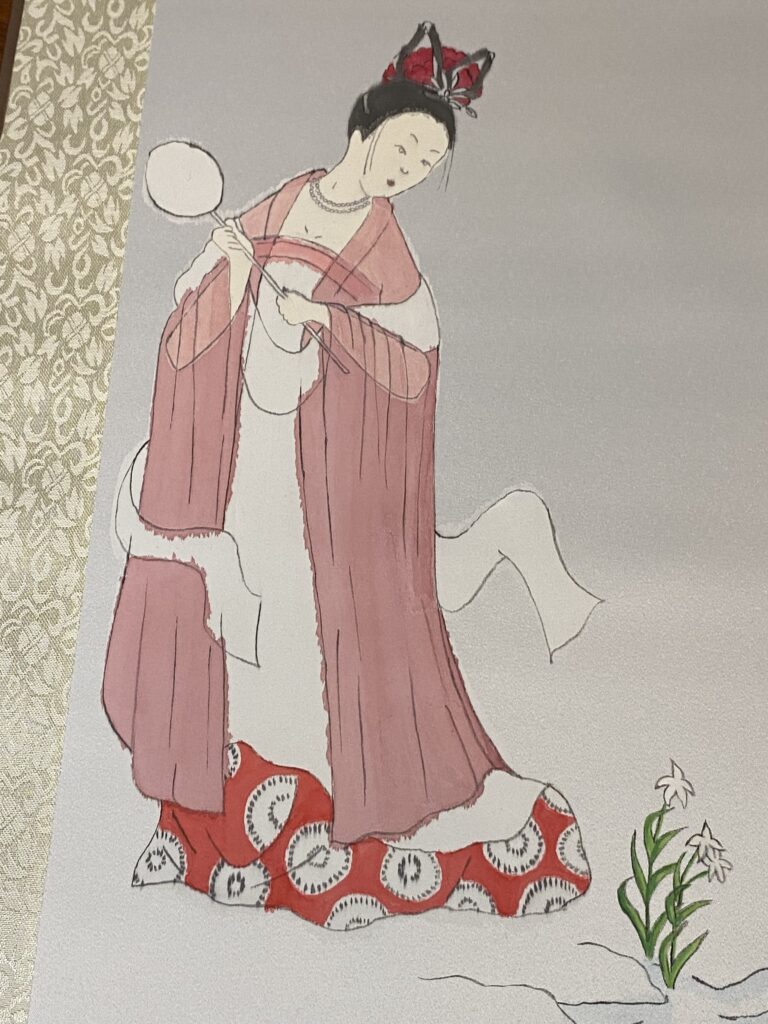
Baroness Audrye’s Challenge ends, and instead of a finished scroll, the scroll has to be started over. Fail one. I attempted to use the paper scroll blank and found very quickly that it would have the same bleeding issues. Fail two. At least fail two was quick and relatively painless.
So I changed the proportions of the image just slightly, lowering the moon and changing the pond bank on the right side and transferred the image onto pergamenata. I also correct a mistake in the skirts that I found after zooming in to see the fabric details on the lower skirt. Because of the resize I left the lilies off as they would need a bit of redrawing to fit properly, and since I was redrawing them, I decided to pull them more in line with the period images as I think they look very western. In the end, I decided to leave them off entirely.
June 19 – First layers of paint added to the scroll.
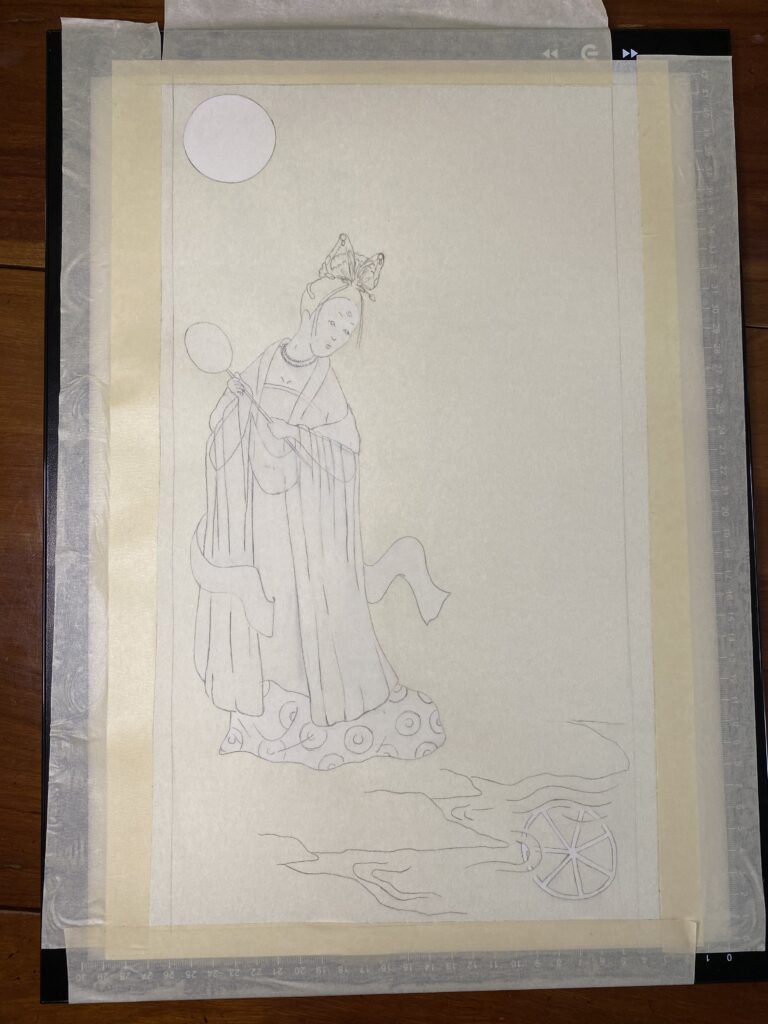
June 21 – Another layer of white base on the figure, moon and wheel. Flower and water painted.
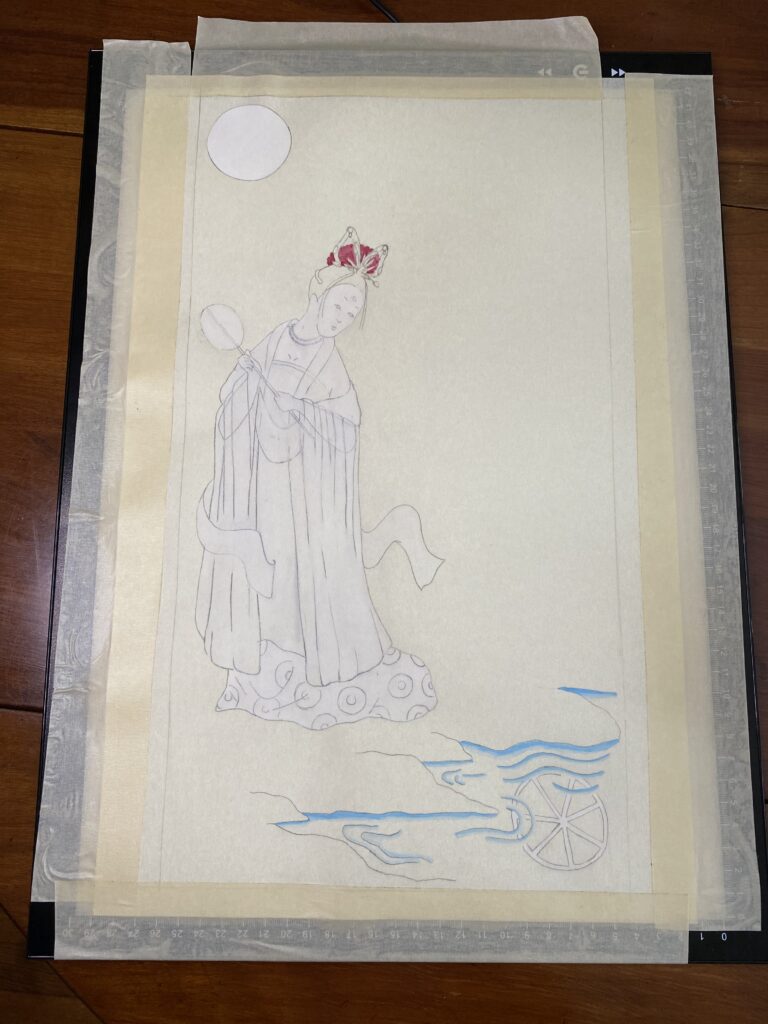
June 23 – Silver added to the moon and wheel. Large color block is painted. The perg has gone wavy on me despite being taped to my lightpad. The scroll is in an “ugly phase” and I worry that I’ve created another failed attempt. I go to the art supply store and buy all new brushes.
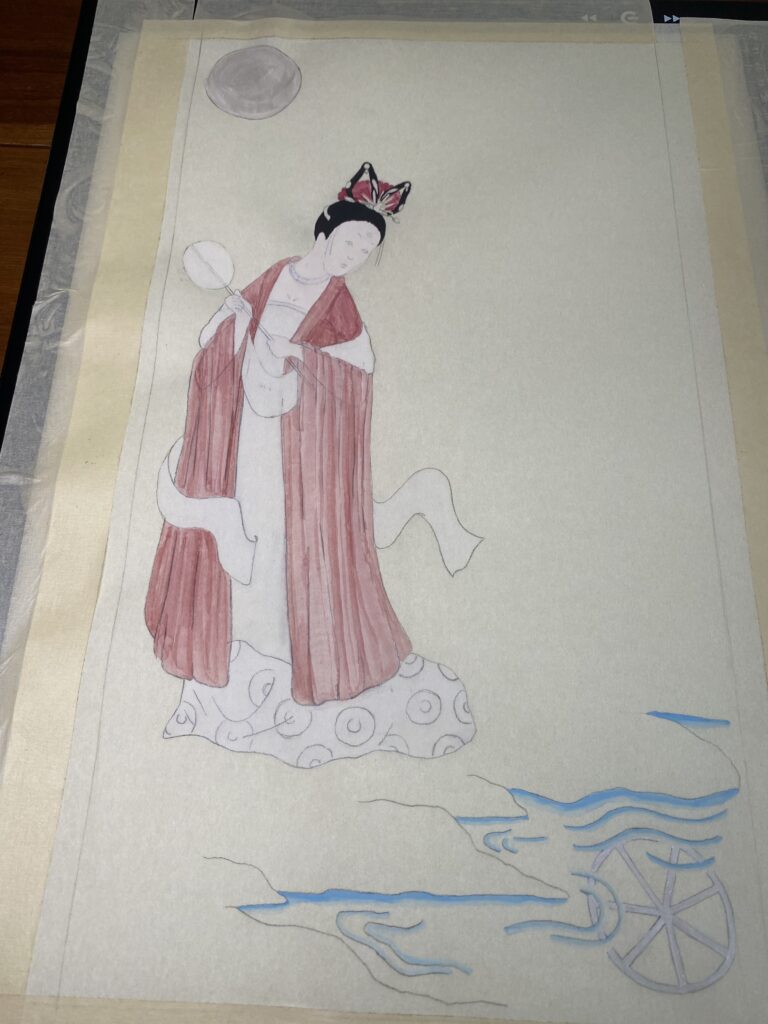
June 24 – Lower skirt painted.
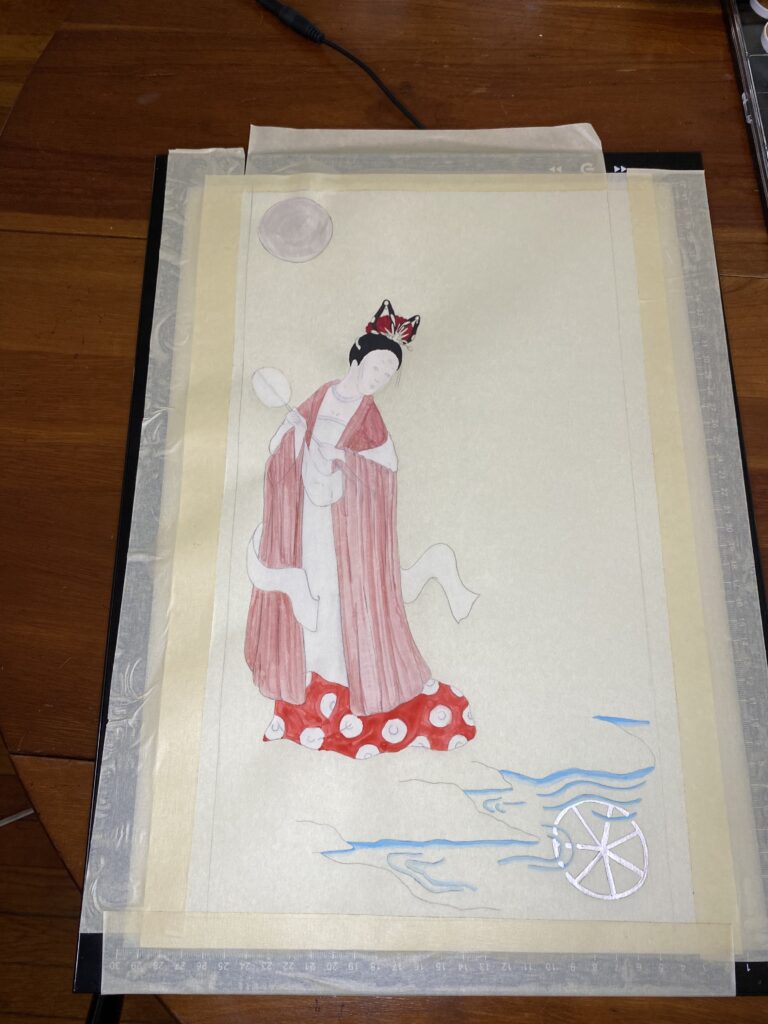
June 25 – Repainting the lower skirt, moon, wheel and flower. Detail at the bust painted.

June 26 – Gold details added. I also used a brush with just a little water to “erase” a bit of paint from the figure’s shoulder. Pattern added to underdress. The scarf has been given another coat of white. The fan is given another coat of white, this time on top of the gold of the handle/support to create a sheer fabric effect. Tiny black details added to the gold in the lower skirt.
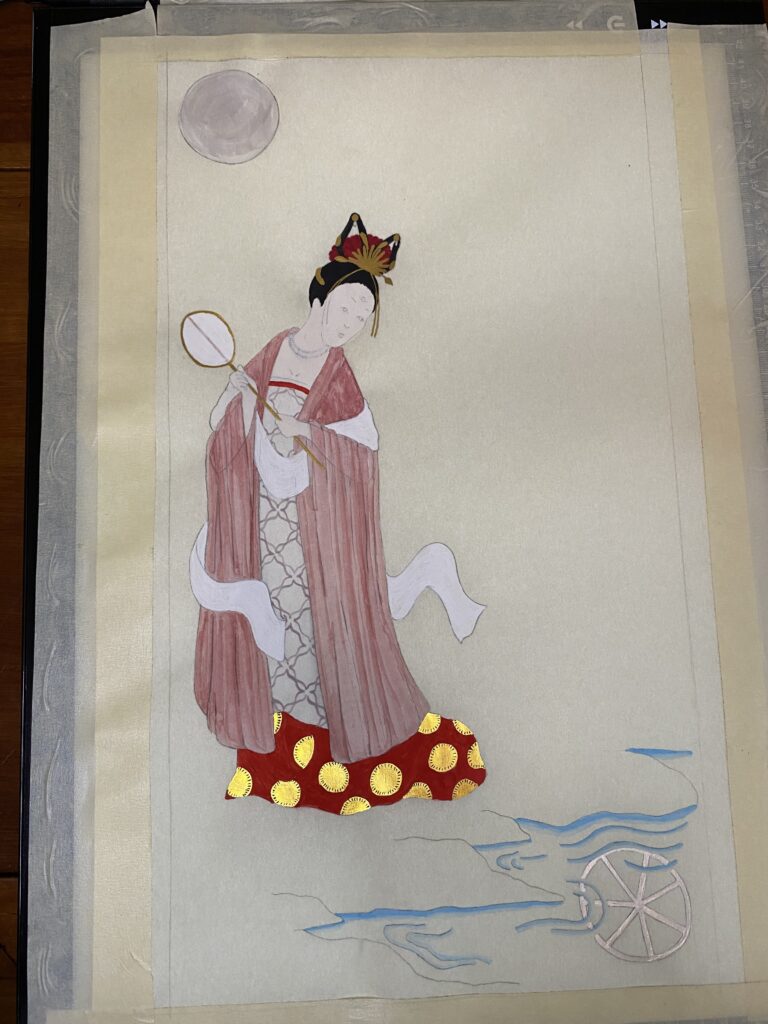
I add white and black details to the headdress and begin the black outlining with the headdress and moon.

Black outline and details added. Makeup and face details painted.
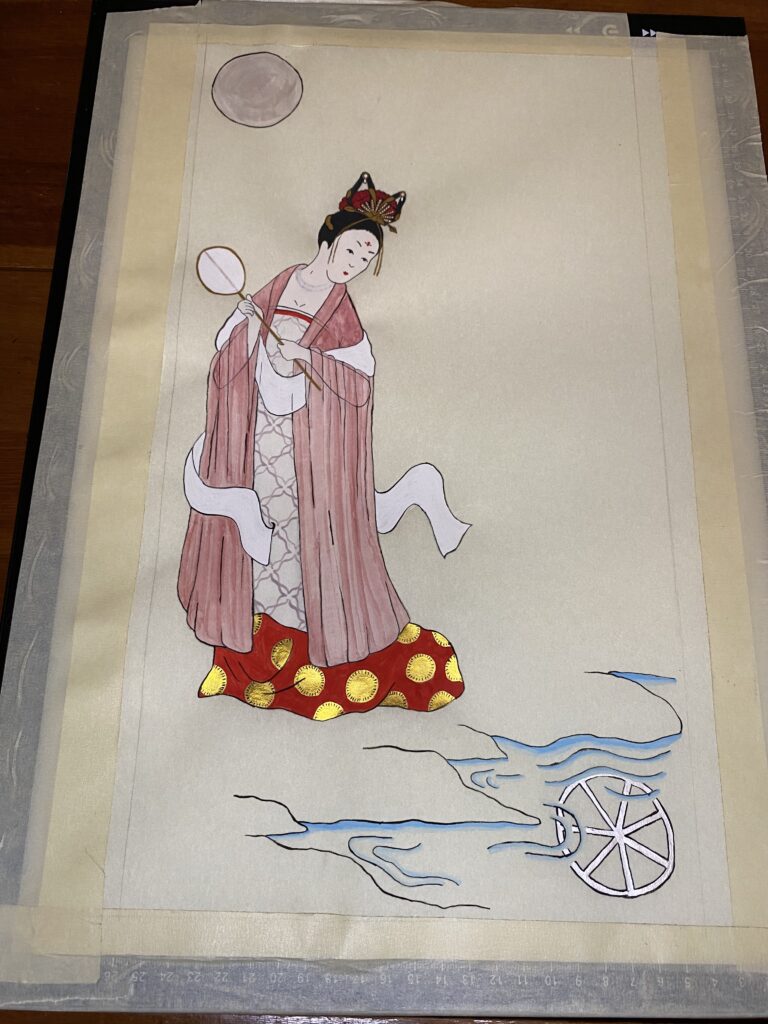
June 27 – Necklace painted. The illumination part of the scroll is complete.
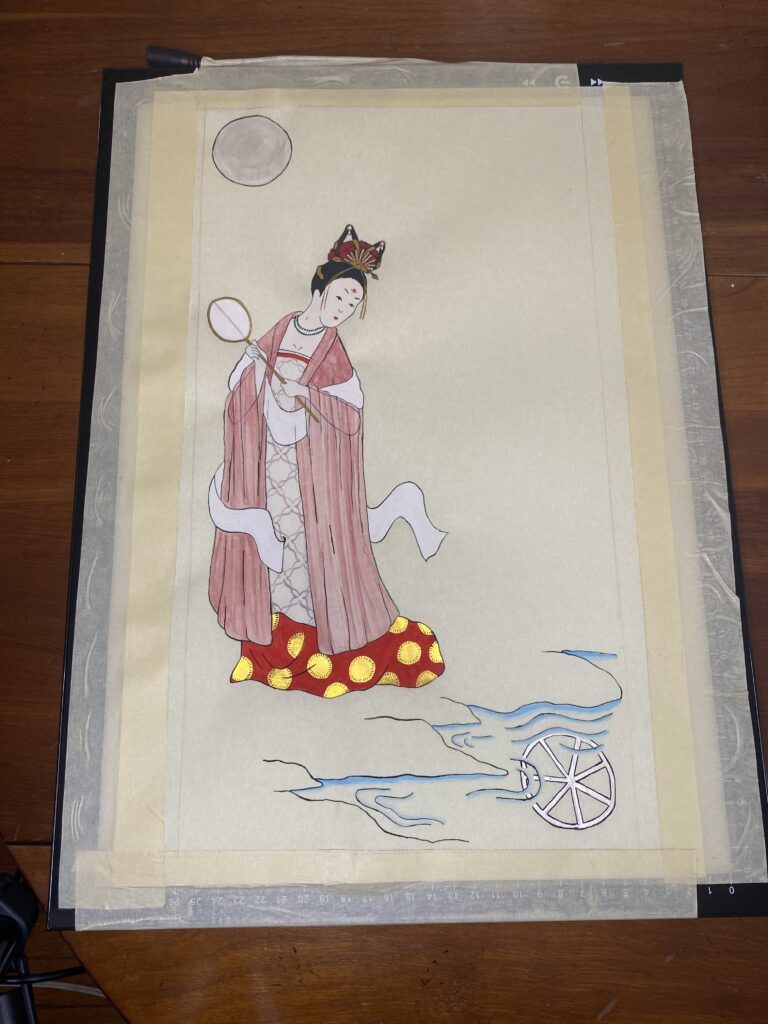
June 29 – I am not a calligrapher. I have always “drawn” any calligraphy I’ve done. I have no experience with Chinese calligraphy and barely any practice in Japanese calligraphy. I know that my brushstrokes will not be in the right order or even direction, but I know that I can copy the characters and they will be legible. First, practice. I can’t get the detail I need with a traditional brush. I practice the calligraphy with an archival brush pen and then with an 18/0 round brush and gouache. My lines are more fine and clear with the paint.
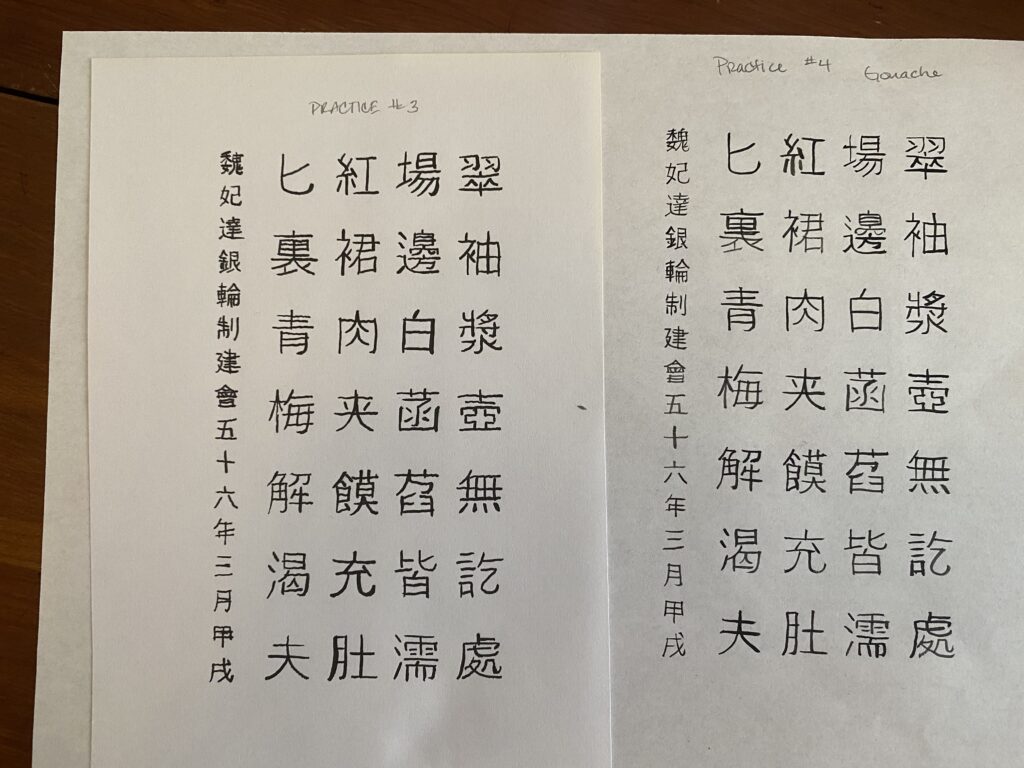
June 30 – The calligraphy is complete and with it, the scroll.
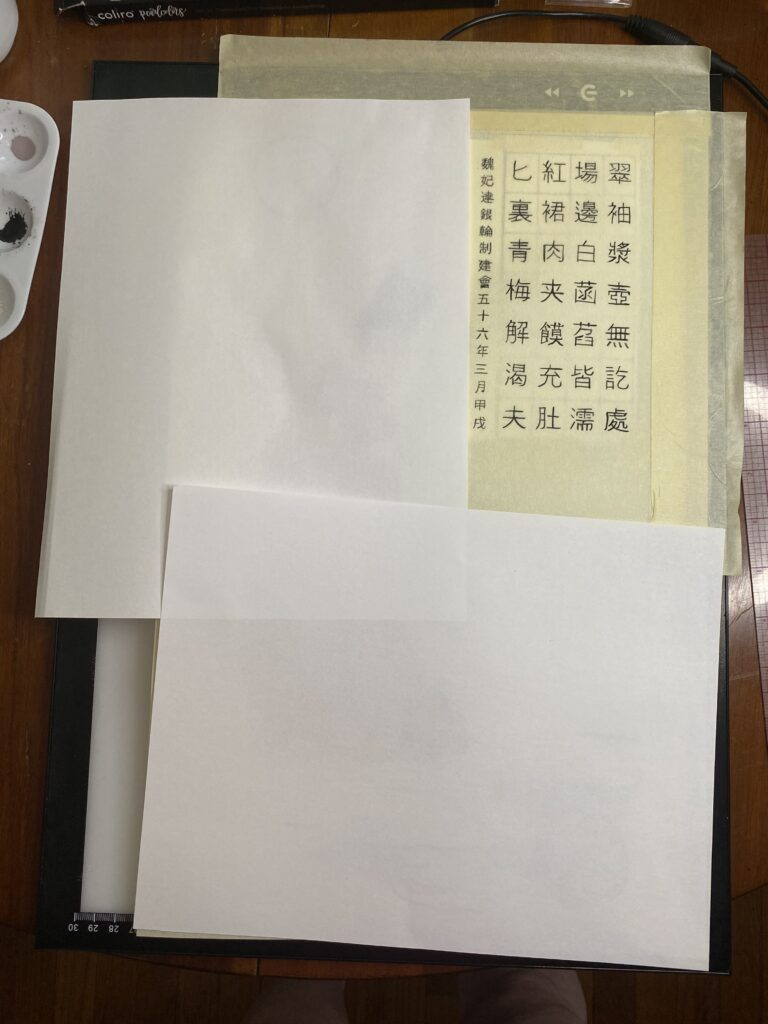
The first person who got to see it was the wordsmith. The two people I took into my confidence so I could ask for artistic help were given sneak peeks. I take the best picture I can of it and send that off with the words to the appropriate place.
July 1 – I create a scroll holder out of foam core boards, copy paper and masking tape to protect the scroll until it is delivered.
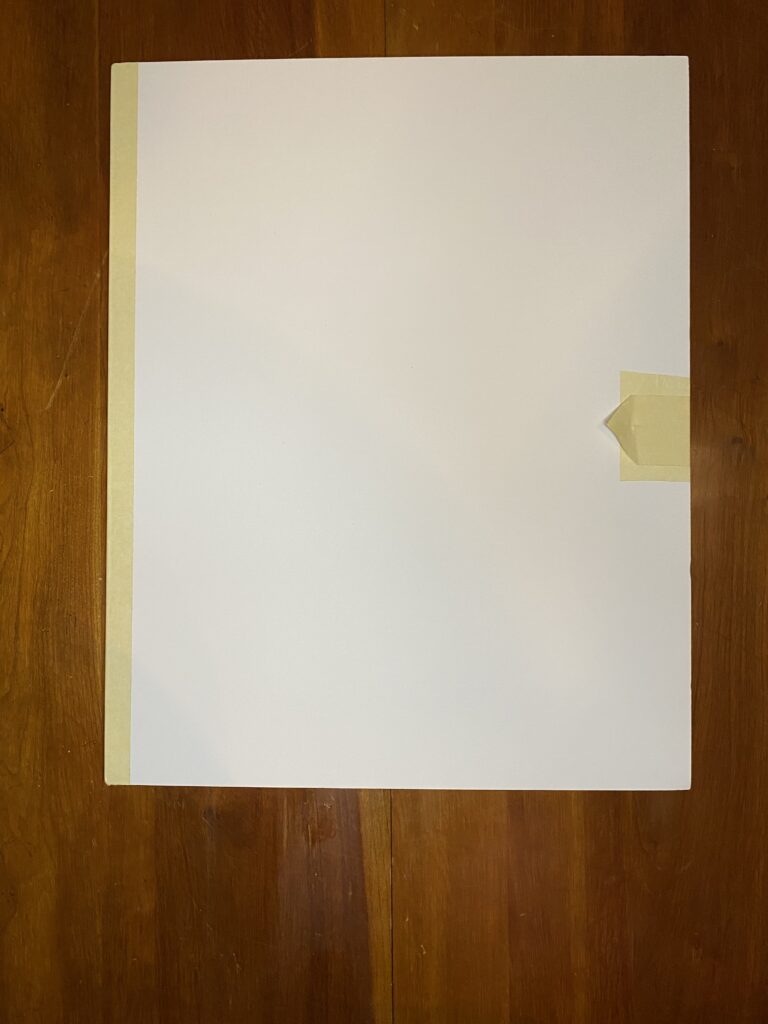

July 11 – The scroll image is shown in court. The recipient loves it.
July 12 – Scroll delivered to the Vox.
Big lessons learned:
(1) ALWAYS zoom in as far as you can on your examples. There are some small changes I made in the finished version of the scroll that would have been made into bigger changes earlier in the process if I had zoomed ALL the way in.
(2) It’s good to have someone to talk to about a secret project.
(3) Practice. I already knew this one, but we can all use the reminder.
(4) Always have a backup plan. And a backup to your backup. The final scroll was my plan C.
(5) Invest in your tools. They really make a difference. This project was made so much easier with new high quality brushes and a great lightpad. My ring light was also invaluable.
